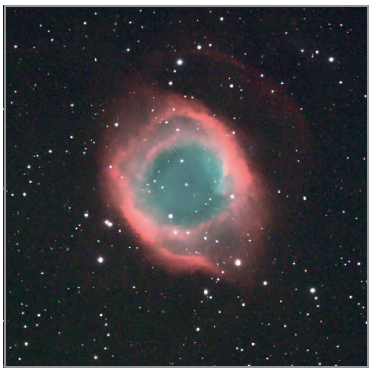
The following excerpt is taken from the book Astrophotography by Thierry Legault.
The term deep-sky encompasses different families of celestial objects quite varied in nature, dimension, and morphology. Special attention must be paid to the wavelengths of luminous radiation they emit because the optimal way to photograph them and to process the resulting images is deeply linked to this attribute.
Stars
Like the sun, the stars glow with a continuous spectrum: all wavelengths (all colors) of visible light are represented in various proportions depending on the surface temperature and composition. The most massive and hottest stars look bluish, while smaller and colder stars look reddish and emit little green and blue light. The sun is a yellow-white star.
Open clusters such as the Double Cluster in Perseus are numerous in the Milky Way and often contain young, hot stars. Their apparent angular size range is quite variable and can exceed one degree, as in the case of the Pleiades or the Hyades, famous open clusters in Taurus.
Globular clusters are old and mainly made up of old and yellowish stars; these stars have a much longer lifetime than the massive ones you’ll find in open clusters.
There are several hundred globular clusters surrounding our galaxy. The most impressive are in the southern celestial hemisphere. Omega Centauri, whose apparent diameter is 1°, and 47 Tucanae, in the vicinity of the Small Magellanic Cloud (SMC), are both examples of globular clusters. Omega Centauri is visible for viewers observing from south of about 30° north latitude. In the Northern Hemisphere, the most famous is M13 in Hercules, spanning 20 arc minutes.
Outside the vicinity of our galaxy, the biggest globular clusters surrounding other galaxies like M31 (the Andromeda Galaxy) and M104 (the Sombrero Galaxy) can be photographed as very small diffuse patches.
Some close stars show measurable movement against the background stars. The fastest is Barnard’s Star in Ophiuchus, six light-years from the sun, with an apparent speed of 10 arc seconds per year, which makes its movement easily detected on photographs taken one year apart. Its magnitude is 9.5.
Diffuse Nebulae
Diffuse nebulae are large clouds of gas (mainly hydrogen) and interstellar dust that give birth to stars. Almost all nebulae that amateurs can photograph belong to our galaxy and therefore are more numerous in the Milky Way. For photography, two main types must be considered: reflection nebulae and emission nebulae.
Reflection nebulae are illuminated by nearby stars. They show a continuous spectrum, with a bluish tint caused by the preferential scattering of blue light by very small particles of dust. The most famous are the nebulae that surround the main stars of the Pleiades and NGC 1975, which lies in the shadow of its neighbor M42 (the Orion Nebula).
Emission nebulae are more numerous and possess a totally different spectral signature. Their matter is ionized by radiation from surrounding stars, reflecting little of this light, reemitting it instead. This emission of light occurs within extremely narrow-wavelength bands, with precise values that physicists call monochromatic emission lines. The spectrum of the nebulae is discontinuous and gives information about their chemical composition because each element (hydrogen, oxygen, sulfur, nitrogen, helium, etc.) has its own emission line wavelengths. Two of these elements are most prominent in the visible spectrum:
- Hydrogen, which emits a series of lines, the main ones 656.3 nm (the Hα line) and 486.1 nm (the Hβ line). Hα and Hβ are pronounced H alpha and H beta, respectively.
- The doubly ionized oxygen that emits two lines at 495.9 nm and 500.7 nm (the OIII lines), the longer wavelength line is always more intense than the first. OIII is pronounced O three.
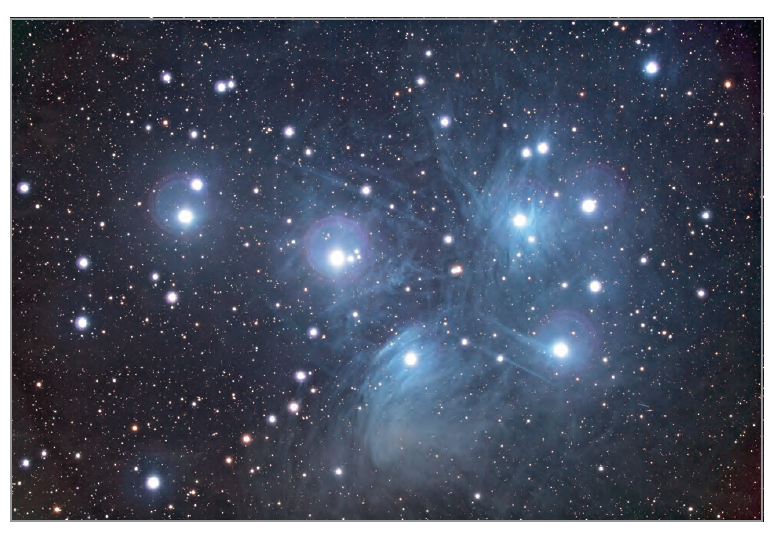
The main stars of the Pleiades are surrounded by reflection nebulae
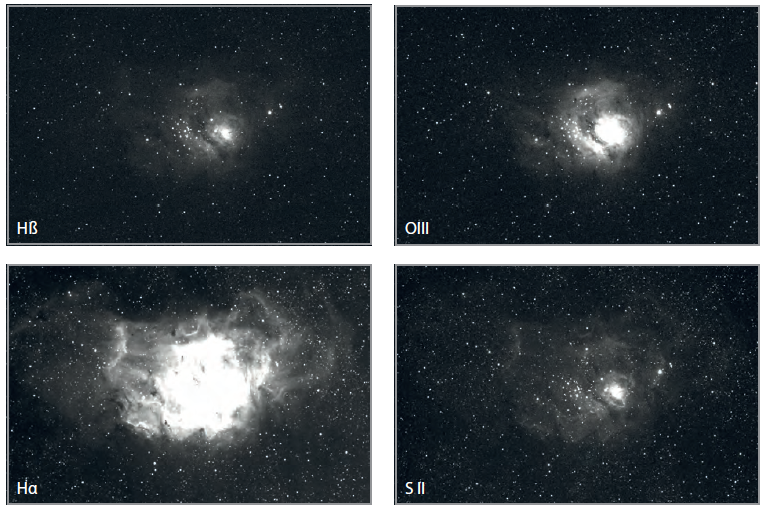
The relative proportions of different emission lines in the light of M8, the Lagoon Nebula in Sagittarius
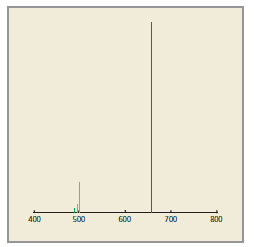
The main spectral lines of emission nebulae: from left to right: Hβ, OIII (double line), Hα. The relative intensities may vary from one nebula to another, but Hα is always dominant, followed by OIII and Hβ.
Some other lines can be found in nebulae, especially SII (ionized sulfur) in the deep red, not far from Hα at 674 nm.
The true color of each emission line can be assessed by looking through the filters toward a white surface, during the day. The Hα line is deep red, the Hβ is blue-green, and the OIII lines, although theoretically placed at the limit between green and blue, are greener. The Hα line always dominates; for many nebulae it is the only line that’s easily detectable. Unfortunately, our night-adapted vision is almost blind to this wavelength.
When we observe emission nebulae through a telescope, our eye mainly perceives the OIII lines, giving the brightest nebulae their greenish tint. We do not see the colors of the fainter nebulae since our night-adapted vision sees objects in black and white (all cats are gray in the dark!).
There is one other type of nebula: the dark nebulae. Without any nearby or internal star, they do not reflect or emit light. They are visible only because they mask the stars or the bright nebulae behind them. The most famous are the Coalsack (a big dark nebula in the Southern Cross) and the Horsehead Nebula in Orion, the area around the Horsehead showing all types of nebulae: emission, reflection, and dark (photograph on page 24).
The range of angular sizes of emission nebulae is broad, with the largest spanning several degrees. By the way, is it difficult to give precise limits to the large nebulae complexes such as in Orion that encompass the area of M42, the Horsehead Nebula, and Barnard’s Loop.
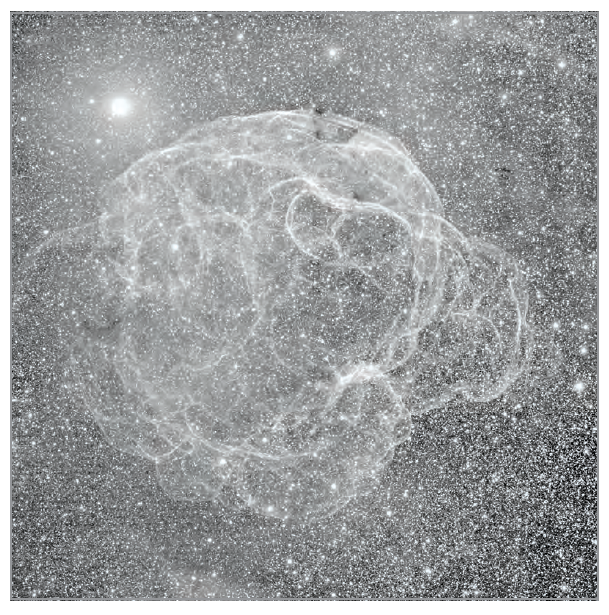
Simeis 147 (also known as Sh2–240) is a supernova remnant about 40,000 years old. It spans more than 3° between Taurus and Auriga. Its low brightness required several hours of exposure with a CCD camera, an Hα filter, and a 300mm telephoto lens in December 2007, when the planet Mars (top left) visited the area.
Planetary Nebulae
Planetary nebulae are shells of matter with a quasi-symmetric shape surrounding a star. Their name comes from the fact that astronomers thought that they were gas and dusk cocoons surrounding a young star and a budding planetary system. Nowadays we know that they are actually stars that have expelled a part of their matter into space at the end of their life. Their radiation, essentially entirely composed of spectral lines, is close to that of the emission nebulae. Numerous chemical elements are detectable, but mostly hydrogen and oxygen again. Relative intensities of lines differ from one planetary nebula to another, but it is generally OIII at 500.7 nm that dominates, giving the brightest ones their characteristic greenish tint. After OIII at 495.9nm, Hα and Hβ are the next most prominent spectral lines.

The contribution of different emission lines to the visible radiation of M27, the Dumbbell Nebula in Vulpecula. Notice the deep morphological difference between the OIII and Hα regions.
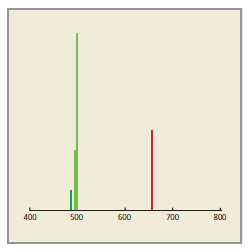
The main lines of planetary nebulae are identical to those of emission nebulae, but this time OIII is generally dominant.

The Helix Nebula, photographed with a CCD camera and broadband RGB filters. Hα constitutes most of the light of the external shell, while OIII is mainly visible in the central area. There is a second external shell, much dimmer than the rest of the nebula, of which a portion is discernable in the top of the image.
Other lines can be found, especially sulfur and helium, in addition to an ionized nitrogen line at 658.4 nm (NII), very close to Hα and very bright in M57 (the Ring Nebula in Lyra). NII is so close to Hα (2 nm) that it can be separated from its neighbor only with the narrowest available Hα filters (3 nm) coupled with a telescope with a high focal ratio (at least 8). For instance, at f/5, the rays arriving from the edges of the telescope aperture pass through the filter with an angle of 5.7° from the normal, which causes a shift of the NII filter bandpass of 1.5 nm toward the blue, almost on top of the Hα line. Since this wavelength shift is inversely proportional to the square of the focal ratio, it is reduced by 4—from f/5 to f/10. If the filter has a bandpass greater than 4 nm, both lines get mixed together.
The planetary nebula with the largest apparent diameter is NGC 7293, the Helix Nebula in Aquarius, which spans about half the angular size of the full moon. It is followed by M27, which measures 7 arc minutes. Most planetary nebulae are smaller than 1 arc minute and you therefore need a longer focal length and finer sampling than most emission nebulae to obtain a detailed view.
